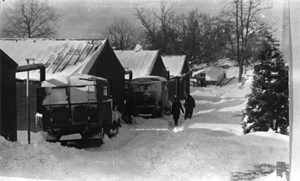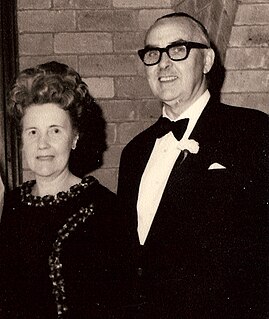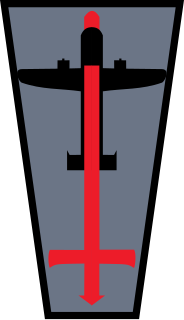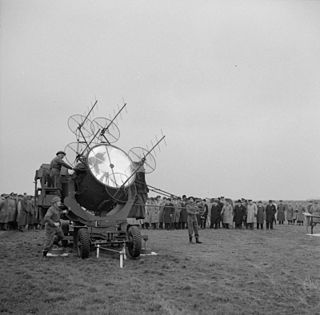Related Research Articles

A searchlight is an apparatus that combines an extremely bright source with a mirrored parabolic reflector to project a powerful beam of light of approximately parallel rays in a particular direction. It is usually constructed so that it can be swiveled about.

The Royal Aircraft Establishment (RAE) was a British research establishment, known by several different names during its history, that eventually came under the aegis of the UK Ministry of Defence (MoD), before finally losing its identity in mergers with other institutions.

The Telecommunications Research Establishment (TRE) was the main United Kingdom research and development organization for radio navigation, radar, infra-red detection for heat seeking missiles, and related work for the Royal Air Force (RAF) during World War II and the years that followed. It was regarded as "the most brilliant and successful of the English wartime research establishments" under "Rowe, who saw more of the English scientific choices between 1935 and 1945 than any single man."
The Ministry of Supply (MoS) was a department of the UK government formed in 1939 to co-ordinate the supply of equipment to all three British armed forces, headed by the Minister of Supply. A separate ministry, however, was responsible for aircraft production, and the Admiralty retained responsibilities for supplying the Royal Navy. During the war years the MoS was based at Shell Mex House in The Strand, London.
The Aeroplane and Armament Experimental Establishment (A&AEE) was a research facility for British military aviation from 1918 to 1992. Established at Martlesham Heath, Suffolk, the unit moved in 1939 to Boscombe Down, Wiltshire, where its work continues following privatisation as part of the Qinetiq company.

The 14th Searchlight Battery was a Finnish anti-aircraft searchlight battery formed from women of the Lotta Svärd organization at the end of the Continuation War. The battery was formed to free some men for other tasks and was used in the air-defence of Helsinki. The battery was the only armed unit in Finnish Army made up from women that was organized as a military unit fit for combat duty. The searchlight battery was operational from late summer 1944 to the end of the Continuation War but did not see action.

William Alan Stewart Butement was a New Zealand-born British-Australian defence scientist and public servant. A native of New Zealand, he made extensive contributions to radar development in Great Britain during World War II, served as the first chief scientist for the Australian Defence Scientific Service, then ended his professional career with a research position in private business.

The 1st Anti-Aircraft Division was an Air Defence formation of the British Army before and during the early years of the Second World War. It defended London during the Battle of Britain and The Blitz.
The London Electrical Engineers was a Volunteer unit of the British Army's Royal Engineers founded in 1897. It pioneered the use of searchlights (S/Ls) for port defence before World War I and for anti-aircraft (AA) defence during the war. In the interwar period it formed the two senior searchlight regiments of the Territorial Army, which defended Southern England during The Blitz. Detachments later served in the Battle of Crete and Siege of Tobruk.
28th Anti-Aircraft Brigade was an air defence formation of the British Territorial Army created in 1925 to command anti-aircraft units in Kent and around the militarily important Medway Towns, which it defended during the Second World War. In 1940 the brigade was responsible for the defences on the south side of the Thames Estuary including the Royal Naval Dockyard at Chatham and the Port of Dover. The brigade was heavily engaged throughout the Battle of Britain, in the summer of 1940, and The Blitz, from autumn 1940 to spring 1941, operating a total of 70 heavy anti-aircraft (HAA) guns controlled from a gun operations room (GOR) at Chatham. During 1942 many of the brigade's experienced units were transferred to active theatres overseas. Increasingly the brigade included women of the Auxiliary Territorial Service (ATS).
29th Anti-Aircraft Brigade was an air defence formation of Britain's Territorial Army (TA) before and during the Second World War. It defended East Anglian airfields and ports during the Battle of Britain and The Blitz. It was reformed in the postwar TA.

The Army Anti-Aircraft Badge or Army Flak Badge was a German military decoration awarded to German Army personnel for service in an anti-aircraft battery during World War II. Designed by Wilhelm Ernst Peekhaus, it was of single piece construction. The pin back and clasp badge was grey metal in color. The badge was made in one grade; it had the national eagle at the top and an oak leaf wreath around the outside rim. In the middle was an 88 mm flak gun with the barrel facing upwards to the "viewer's" right.
The 38th Light Anti-Aircraft Brigade was an air defence formation of Britain's Territorial Army formed just before the Second World War, which protected London and Southern England during the Blitz and later converted into an infantry formation for the liberation of Europe.

The 2nd Anti-Aircraft Division was an Air Defence formation of the British Army from 1935 to 1942. It controlled anti-aircraft gun and searchlight units of the Territorial Army (TA) defending the East Midlands and East Anglia during The Blitz.
The 54th Anti-Aircraft Brigade was an air defence formation of Britain's Territorial Army (TA) formed immediately before the outbreak of the Second World War. It was engaged in defending the West Midlands of England during the war. It comprised a varying number of searchlight (S/L) battalions and later included light anti-aircraft units. It was disbanded at the end of 1943. When the TA was reconstituted in 1947, the former 54th AA Bde was reformed as 80 Anti-Aircraft Brigade but was disbanded on 9 September 1948.
The Tyne Electrical Engineers (TEE) is a Volunteer unit of the British Army that has existed under various titles since 1860. It has been the parent unit for a large number of units fulfilling specialist coastal and air defence roles in the Royal Engineers (RE) and Royal Artillery (RA), many seeing service during both World Wars. TEE companies currently form part of the RE and of the Royal Electrical and Mechanical Engineers in the Army Reserve.
The Essex (Fortress) Royal Engineers was a volunteer unit of Britain's Royal Engineers formed to defend the Essex coast. It served in this role in World War I and then converted to a searchlight regiment for air defence in World War II. The unit ended the war as a garrison infantry battalion. Its descendants continued to serve in the Territorial Army until 1955.

Searchlight Control, SLC for short but nicknamed "Elsie", was a British Army VHF-band radar system that provided aiming guidance to an attached searchlight. By combining a searchlight with a radar, the radar did not have to be particularly accurate, it only had to be good enough to get the searchlight beam on the target. Once the target was lit, normal optical instruments could be used to guide the associated anti-aircraft artillery. This allowed the radar to be much smaller, simpler and less expensive than a system with enough accuracy to directly aim the guns, like the large and complex GL Mk. II radar. In 1943 the system was officially designated Radar, AA, No. 2, although this name is rarely used.
The Air Defence Experimental Establishment (ADEE) was a civil agency run by the British War Office, the civilian side of the British Army. It was primarily tasked with developing sound ranging of enemy artillery, and the development of anti-aircraft weapons and techniques, notably searchlights.
References
- "MoD – History of Innovation" (PDF). Ploughshare Innovations (UK Ministry of Defence).